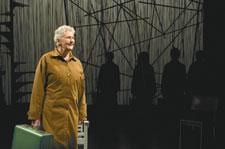Michel Tremblay’s Albertine in Five Times is a powerful exploration of the life of one woman during five distinct periods in her life. In his title character the playwright has created an individual of enormous independence, warmth and complexity who not only reveals to her audience the different stages of a single life, but also the intricate ways in which memory simultaneously enlightens and confuses our views of the past, the present and the future. Ultimately an uplifting text that moves us through a frequently harrowing familial journey, this is a 90-minute tour de force that allows six actresses to depict Albertine — and her sister Madeleine — with an acute interconnectedness that renders a believable individual persona for an audience to observe as she passes through 70 years of living.
The current Shaw production of Tremblay’s masterpiece is flawless.
Set within the evocative confines of designer Teresa Przbylski’s powerful set (five chairs and a chaotic wrought-iron backdrop) the performers mingle on the smallish Court House stage with an appropriately claustrophobic intensity that director Micheline Chevrier has crafted into moments of stark individuality and ensemble perfection. From Marla McLean’s bright-eyed sincerity, Jenny L Wright’s glowing bitterness, Mary Haney’s efficient romanticism, to Wendy Thatcher’s seering decay and delusion and Patricia Hamilton’s reserved, agitated grace — plus Nicolá Correia-Damude’s supportive, soul-searching, endearing Madeleine — this ensemble achieves the impossible task of rendering Albertine, from ages 30 to 70, in distinct shades that bring her together into one coherent character. Other productions have been marked by a difficult transition from one very distinct performance to the next that, although impressive, have not congealed into a single character who unfolds through the bodies of five women who the audience can believe as one Albertine.
As one of Canada’s preeminent gay playwrights Tremblay has shown us, with an acute and diverse sensibility, that a man marginalized by sexual proclivity can explore the life of a straight female from the perspective of a gay male. From this double-edged vantage point he has created incredibly powerful and enlightening women’s roles that both defy and define the limits of memory at 10-year intervals, from the brink of youth to the edge of old age.

 Why you can trust Xtra
Why you can trust Xtra


